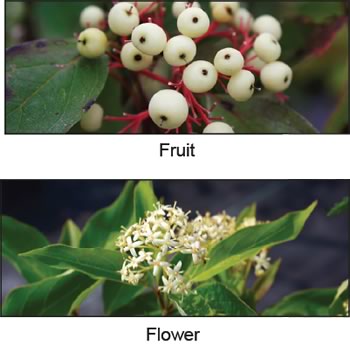Gray Dogwood
The Gray Dogwood is very adaptable. Can withstand many kinds of soil and looks good all year round.
Cornus racemosa aka Gray Dogwood and Panicled Dogwood. The Gray Dogwood is very adaptable. Can withstand many kinds of soil. Looks good all year round. Shrub will grow in thickets creating shelter for small mammals and birds and is an excellent plant for erosion control and naturalized areas. Deer resistant and attracts pollinators.
Gray Dogwood Characteristics
 Leaves: Medium green to gray-green turning a mixture of green, purple, and red in October.
Leaves: Medium green to gray-green turning a mixture of green, purple, and red in October.
Stem/Bark: Very thin stems are dark red to purplish-red. Bark changes from reddish brown stems to gray branches (hence the common name) with age.
Flower: Small white flowers in a flat-topped clusters, 2 inches in diameter that appear in late May and early June.
Fruit/Nut: White, bluish-white berry clusters appear on red stalks in August-September.
Habit: Upright, multi-stemmed shrub when young that suckers with short spreading branches becoming a spreading mound or open habit with age.
Hardiness: Zone 3
Height: 10’ – 15’
Width: 10’ – 15’
Why grow native plants?
A native plant is defined as a species of fauna that was already established before colonization. There are numerous benefits to the use of Native Plants. Native plants have grown and evolved in a given area for generations and therefore are more prepared to face the elements. As a result they are much hardier and less finicky to care for. The wildlife in the area has also evolved along side these plants, and because of this has formed bonds with them. Most butterflies have a specific plant species from which they collect nectar for their offspring. There are many birds that will feed directly from local trees for seed, nectar or fruit, but won’t use the bird feeder you’ve bought to attract them. These plants also work together to grow as natural plant communities. Most of the trees won’t grow their leaves until after the wildflowers have had an adequate amount of time to flower before they’re covered by shade. Finally, of course, there is the fact that all of these plants and animals combine to make a sustainable, complete, functioning ecosystem. Why fight thousands of years of evolution?
Have questions about native plants? Post a comment Ian will get back to you.






